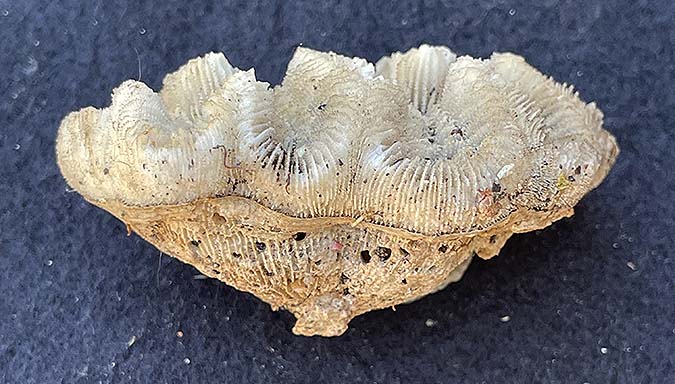Colonial-stony corals (also called hexacorals or scleractinians) belong to phylum Coelenterata. The geologic range of colonial-stony corals is Middle Triassic to modern day. This blog post concerns the hematypic hexacorals, which are the ones that harbor symbiotic algae and, therefore, can be reef builders.
A reef is a wave-resistant, ridgelike or moundlike structure, built from the remains of reef-building organisms (colonial corals, red algae [e.g., Lithothamnion], green algae, as well as the remains of mollusks, echinoderms, crustaceans, bryozoans, microscopic foraminiferans, and other animals). A reef also consists of in situ organic-constructed unstratified rock. If a wooden ship hits a reef, it could sink the ship! Only the upper crust of a reef is alive and growing. Coral reefs have always been are restricted to the tropics in shallow-warm waters. Today, coral reefs occur between latitudes 30°N and 30°S.
One might think that the identification of reef corals is simple, but the process is not easy. There are at least 100 genera of modern-day, reef corals, but there are only a few (less than 10) basic shapes (e.g., massive, branched, columnar, domed, sheet-like, furrow-like). And these shapes are not confined to any one genus (Wood, 1983). The skeletons of colonial corals are referred to as the corallum, and the individual polyps (corallites) that comprise these skeletons can be very similar looking. These similarities include the size, spacing, and number of septa (radial partitions) in the centers of the individual polyps. That is why the title of this blog post is appropriate.
note: In the figures shown below, each respective
caption is just below each figure.
Styloceniella? sp. (two views: overall coral corallum and a closeup). The specimen is 14 cm tall and 10 cm wide. It has an overall “domed” shape with small knobs. The polyps are crowded closely together, and the septa within the polyps are short and small. According to Wood (1983, p. 71), this genus is confined to the Indo-Pacific region and often grows in crevices or on the undersides of rocks or other corals.
Echinophora sp. (two views: oblique side and top). The specimen is height 6 cm and width 7.5 cm. The genus is found in the Indo-Pacific region. Echinophora is a “shape shifter” as its skeleton can be from branching, flat, fan-like or leaf like, or even the very distinctive wide-cup shape (like the specimen illustrated here).
Oulophyllia? sp. (three views: side, top, and closeup or a single corallite). The specimen is 6.7 cm long, 4 cm wide, and 3.5 cm tall. It has a meandroid shape, with “valleys.” It is an Indo-Pacific coral.
Pavona sp. (Three views: coral head, close up, and more close up). This heavy specimen is 28 cm long and 21 cm wide. It is an Indo-Pacific coral and is fairly common. There is great variability in morphology of this coral genus (Wood, 1983, p. 90).
Reference Cited:
Wood, E.M. 1983. Corals of the world. T.F.H. Publications. 256 pp.















No comments:
Post a Comment